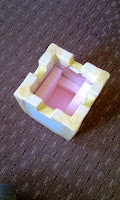I began by assembling the box for the payload. I looked at a few previous projects, drew a couple of sketches, and decided to go with a cube of 20x20x20cm dimensions.
Initially, I intended to fit the box with a camera, my mobile phone and some sort of a thermometer as the payload. Looking back, it is definitely better to know what exactly you want to put in the box ahead. I, unfortunately, changed my plans a couple of times over the months, so I had to additionally modify the box a little bit.
I used 3cm thick polystyrene to carve out the shapes.
To tighten the whole construction, I used a masking tape for painters. It's light and it sticks to polystyrene. Eventually, I used quite a lot of this tape to restrict the polystyrene parts from crumbling away.
Initially, I wanted to test the ability of the box and of the materials to hold warmth. I covered the inner walls with Aluminium kitchen foil and filled the box with several foam blocks.
Put in the thermometer, close the box and off to the freezer.
The box seemed to slow down the temperature drop at least a little bit. But without a source of heat, the temperature inside will eventually match the temperature outside. Lucky for us, the box will include our equipment which does generate heat, thus we'll only need the box to hold it sufficiently inside.
Later, I placed the box on direct sunlight to see whether it doesn't get too hot inside. I recall reading about a couple of occasions where too much heat inside the payload led to the camera malfunctioning and stopping taking pictures.
I then decided to wrap the box in a thermal blanket. I did that to help the box to conserve heat, but due to it blocking the signal to the GPS module, I had to take it off. More on that later.
Because the top lid of the box leaves a lot of crannies, I decided to add another one right below it to secure the insides from the low temperatures. The wire is there to help drag it out once it's time to open the box again.
Just a couple of ideas at the end. The box suspended underneath the balloon tends to swing and circle as the balloon ascends. It is better to use rather longer cords then shorter. When the payload is too close to the balloon, it swings too wildly making it hard for the camera to take a decent shot. Perhaps some sort of stabilizing wings might be useful, but that would require additional testing.


















No comments:
Post a Comment